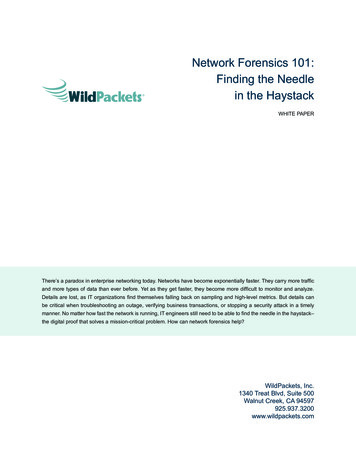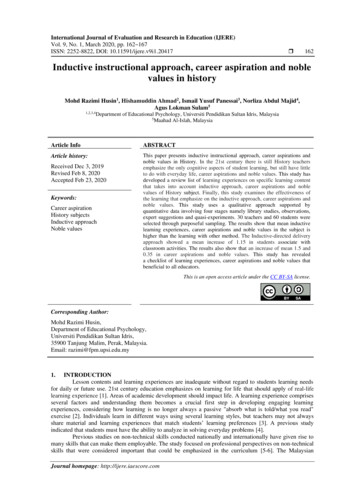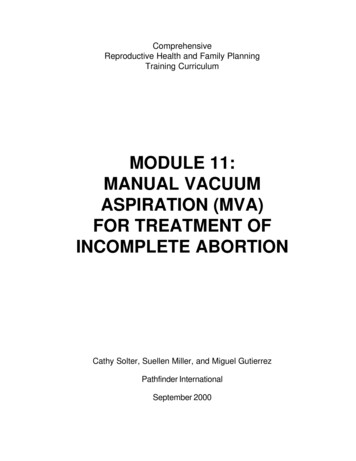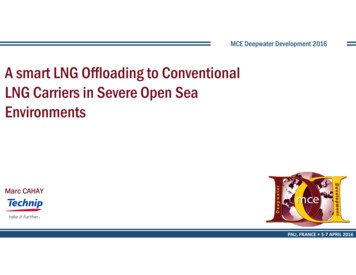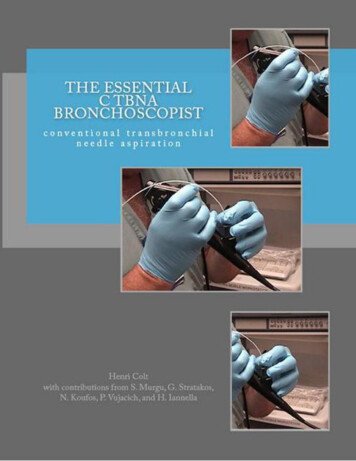
Transcription
FIRST EDITIONThe EssentialcTBNA Bronchoscopistconventional transbronchial needle aspirationHenri Colt MDWith S. Murgu, G. Stratakos, N. Koufos, P. Vujacich, and H. IannellaTHE ESSENTIAL BRONCHOSCOPIST SERIES
THE ESSENTIAL cTBNA BRONCHOSCOPIST Laguna Beach, CA
The Essential cTBNABronchoscopistConventional Transbronchial Needle AspirationModule 1Henri Colt, MD, FCCP, FAWMWith contributions from Drs. Septimiu Murgu, Grigoris Stratakos, Nikos Koufos,Patricia Vujacich and Hernan Iannella
This module was specifically designed for training in conventional transbronchial needle aspiration(cTBNA). The module and its post-test, as well as accompanying interactive Powerpoint presentations are part of a multidimensional curriculum that includes step-by-step hands-oninstruction, simulation, instructional videos, patient-based practical approach exercises, and didacticlectures.This educational program has been designed in collaboration with the following members of theBronchoscopy International team:Dr. Patricia Vujacich (Buenos Aires, Argentina)Dr. Pedro Garcia Mantilla (Lima, Peru)Dr. Grigoris Stratakos (Athens, Greece)Dr. Nikos Koufos (Athens, Greece)Dr. Hernan Iannella (Buenos Aires, Argentina)
Bronchoscopy International, Laguna Beach, CA 92651Copyright 2015, Henri ColtAll rights reserved. No part of this publication may be reproduced or transmitted byany means, electronic or mechanical, including photocopy or information storage andretrieval system, without permission from the publisher.Colt Henri GThe Essential cTBNA Bronchoscopist First Edition, 2015From, The Essential Bronchoscopist SeriesTitle 1: The Essential cTBNA Bronchoscopist; Pulmonary diseases; Thoracic medicineISBN-13: 978-1517342692ISBN-10: 15173426941. The Essential Flexible Bronchoscopist 2. The Essential EBUS Bronchoscopist 3. The Essential cTBNA Bronchoscopist 4. The Essential Intensivist Bronchoscopist5. The Essential Interventional Bronchoscopist6. The Essential of Bronchoscopy Education Manufactured in the United States of America1 2 3 4 5 6 7 8 9 10
FIRST EDITIONThe EssentialcTBNA Bronchoscopistconventional transbronchial needle aspirationHenri Colt MDWith S. Murgu, G. Stratakos, N. Koufos, P. Vujacich, and H. IannellaTHE ESSENTIAL BRONCHOSCOPIST SERIES
Funding statementFunding for The Essential cTBNA Bronchoscopist is a result of collaborative work amongmembers of Bronchoscopy International, The Argentine Association for Bronchology, and thebronchoscopy group of the Hellenic Thoracic Society. No corporate support was either solicitedor received for this work.Copyright statementCopyright2015. Henri Colt MD. All Rights Reserved.Permission to use, copy, modify, and distribute any part of this software including any sourcecode and documentation for educational, research, and non-profit purposes, without fee, andwithout a written agreement is hereby granted, provided that the above copyright notice, andthis paragraph appear in all copies of the documentation.Essential cTBNA Bronchoscopist DisclaimerConfidentiality of data potentially relating to individual patients and visitors has beenrespected. We strive to honor or exceed any legal requirements of medical/health informationprivacy as they apply to the United States and to the state of California. Images and casedescriptions provided here-in, therefore, are not intended for the diagnosis of any specificpatient. Any information found on the website or in this text should not be used as a substitutefor medical care.The authors disclaim liability, injury, or damage incurred as a consequence from the use ofinformation. Reference to websites, instruments, or equipment portrayed in this material is notof commercial nature, nor does the inclusion imply endorsement. Should documents or imagesfrom this material be copied for personal use, we request that materials remain unedited andunmodified unless for teaching purposes, that no fee be charged for copies or access to theinformation, that copyright notices and disclaimers remain attached, and that credit be given toThe Essential cTBNA Bronchoscopist (suggested format cTBNA Bronchoscopist www.http://bronchoscopy.orgAcknowledgementsWe thank all those who have contributed to the art and science of conventional TBNA and whohave helped promote the use of this essential minimally invasive procedure around the world.Particular thanks to Drs. Stefano Gasparini, Hideo Saka, Artemio Garcia, and to the dozens ofphysicians who espouse Bronchoscopy International’s philosophy of an “education withoutborders.”
The Essential ConventionalTBNA BronchoscopistConventional transbronchial needle aspirationTABLE OF CONTENTSModule I9Post-tests module I5Answers to post-tests Congratulations6 About the authors6 §
MODULE 1THIRTY MULTIPLE CHOICE QUESTION/ANSWER SETS9
The Essential cTBNA Bronchoscopist MODULE 1LEARNING OBJECTIVESAfter completing this module the reader should be able to:1. Describe three specific indications for cTBNA in managing patients with lungdisorders.2. Describe the specific locations of lymph node stations 7, 4R and 4L as well asneedle insertion sites to sample these lymph node territories.3. Describe major vascular anatomic structures that are adjacent to lymph nodestations 7, 4R and 4L.4. Describe three different cTBNA techniques (jab, piggyback, and needle to hub).5. Describe ways to protect the flexible bronchoscope from needle-induced damage.6. List at least four different complications from cTBNA7. Specify the role and expected yield of cTBNA among and compared with otherdiagnostic bronchoscopic procedures.8. List three major factors that may improve or decrease the quality of cytologysmears after cTBNA nodal sampling.10
Question I.1 The right pulmonary artery is most adjacent to the anterior wall of the right mainbronchus at:A. The level of the carina near the origin of the right main bronchus.B. The level of the right upper lobe bronchial orifice and origin of the bronchusintermedius.C. The origin of the right lower lobe bronchus above the origin of the superior segmentalbronchus.Answer: BAt the level of the orifice of the right upper lobe bronchus, needle insertion through the anteriorwall of the right main bronchus risks entering the right pulmonary artery, which liesimmediately anterior to the bronchus at this level. Note that the right upper lobe bronchus inthis cast is more vertical than usual.11
Question I.2 Which of the following statements about the right upper lobe bronchus is correct?A. The posterior portion of the right upper lobe bronchus is devoid of any vascularrelationships.B. The anterior portion of the right upper lobe bronchus is devoid of any vascularrelationships.C. The pulmonary vein is in direct contact with the right upper lobe bronchus.Answer: ANo vascular structure is directly adjacent to the posterior aspect of the right upper lobebronchus. Anterior lies the pulmonary vein, but it is not in direct contact with the bronchus. Theright pulmonary artery is adjacent to the anterior wall of the right upper lobe bronchus andorigin of the bronchus intermedius. Needle aspiration at this site would be dangerous. Note thatthe direction of the right upper lobe bronchus in this cast is more vertical than usual.12
Question I.3 While performing transbronchial needle aspiration of nodal station 4R (rightparatracheal), you insert the needle 2 cm above the carina, and laterally at the 3 o’clock position(imagining the interior of the airway as a clock face and using the carina as the central referencepoint). Which of the following is a major anatomic danger?A. The aortaB. The right pulmonary arteryC. The azygos veinD. The esophagusAnswer: CAnterior and to the right of the distal third of the trachea lie the superior vena cava and theazygos vein. Needle insertion at this site risks causing pneumothorax or bleeding. The rightpulmonary artery is anterior to the right main bronchus and origin from the right upper lobebronchus. Needle insertion through the anterior wall of the right main bronchus at the level ofthe origin of the right upper lobe bronchus should be avoided. The esophagus lies closely(within 2-3 mm) behind the posterior wall of the trachea and left main bronchus. Theinnominate artery and the aortic arch lie directly anterior to the trachea, just above the maincarina and coursing slightly to the left of the distal trachea where one can see a slight indent andfaint pulsations. Obviously, it would be unwise to insert a needle into this area!13
Question I.4 During transbronchial needle aspiration of mediastinal lymphadenopathy, whichof the following is most likely to help increase diagnostic yield?A. Performing needle aspiration before airway examination or acquisition of other samples.B. Maintaining suction during needle withdrawal from the lymph node.C. Rinsing the working channel of the bronchoscope before needle insertion.D. Asking the cytopathologist to be present to immediately examine the specimens.Answer: DSeveral studies have shown that Rapid OnSite Examination of cTBNA specimens by a trainedcytopathologist (ROSE) improves diagnostic yield. In addition, this might allow thebronchoscopist to perform fewer needle passes, and might make additional specimens such asbiopsies or brushing less necessary. Most experts recommend rinsing the working channel priorto performing needle aspiration. In addition, in order to avoid false positive results, needleaspiration should be performed prior to airway inspection or biopsies of endobronchialabnormalities. Once the needle (ususally 22G cytology needle) is inserted through the airwaywall and into the tumor or lymph node, suction is applied to obtain the sample. Suction shouldbe released prior to removing the needle from the tumor or lymph node in order to avoid avoidcontamination from bronchial wall tissue. The bronchoscope should not be connected to wallsuction until all needle aspiration samples have been obtained. Using a larger histology needle(19G) might result in greater yield, especially for diagnosis of lymphoma.14
Question I.5 Where are the right paratracheal lymph nodes (IASLC station 4R) in relation to thetrachea?A. Posterior-lateralB. Anterior-lateralC. LateralD. PosteriorAnswer: BNodal station 4R is anterolateral to the trachea, and can be accessed by needle aspiration at asite that is two-four intercartilaginous spaces above the carina, aiming the needle anterolaterallytowards the 1 or 2 o’clock position (imagining the interior of the airway as a clock face andusing the carina as the central reference point). Aiming the needle more laterally riskspuncturing the azygos vein. The paratracheal lymph nodes are generally located slightly lateralto the trachea. They are difficult to access because of the very lateral position required of theneedle and of the tip of the flexible bronchoscope, especially on the left (station 4L oraortopulmonary window node).IASLC level 4R15
Question I.6 Imagining the interior of the airway as a clock face and using the carina as thecentral reference point, transbronchial needle aspiration at the 9 o’clock position along themedial wall of the bronchus intermedius at a level just proximal to the right middle lobebronchial orifice will sample:A. The right lower hilar lymph node.B. The sub-subcarina lymph node.C. The right main bronchus lymph node.D. The sub carina lymph node.Answer: BThe sub-subcarina lymph node is part of an older nomenclature, and is now generally referredto as part of the IASLC level 7 (subcarina) lymph node region. The territory is located betweenthe bronchus intermedius and the left main bronchus, at or near the level of the right middlelobe bronchus. Overall, the level 7 subcarina lymph node region extends caudally to the lowerborder of the bronchus intermedius on the right, and caudally to the upper border of the leftupper lobe bronchus on the left. In order to sample this territory, the needle should be inserteddirectly through or adjacent to the carina in order to sample nodes directly below thebifurcation, or at the 3 o’clock position along the medial wall of the right main bronchus, justproximal to the level of the right upper lobe bronchial orifice (if the bronchoscopist is standingin front of or to the side of the patient), or at the 9 o’ clock position along the medial wall of theright main bronchus (if the operator is standing at the head of the patient).Interlobar nodesIASLC 11LInterobar nodesIASLC 11R inferior16
Aortic archNeedle through bifurcationPulmonary arteryIASLC level 717
Question I.7 When performing transbronchial or transcarinal needle aspiration, which of thefollowing appears to be most important for increasing diagnostic yield?A. Performing up to 7 passes with the cytology needle.B. Performing ROSE (rapid onsite examination) of cTBNA specimens.C. Using the largest and stiffest needle possible.D. Obtaining the needle specimen after bronchoalveolar washings or biopsies.Answer: BThe mean yield of cTBNA is 70-80% in case of lung cancer (sensitivity ranging from 37%-89%with a specificity of 96%), and may be as high as 90% in benign diseases such as sarcoidosiswith a recent metanalysis of 21 studies showing a pooled yield of 62%. Yield is increased whencytopathologists can immediately determine whether samples are representative (ROSE). This isstandard of practice and should be encouraged in institutions where cTBNA is performed.Needle aspiration should be performed BEFORE other specimens are collected in order to avoidcontamination and false positives. While the stiffer, larger-bore, two part histology needleappears helpful for transcarinal sampling, it is more technically challenging to insert throughthe working channel of the flexible bronchoscope and may be impossible to use in more distalairways. Most investigators find that at least 3-5 needle passes are necessary to make adiagnosis, after which diagnostic yield increases very slightly to 7 passes. Experts agree thatcTBNA sensitivity is affected by operator skill and experience, the location and nature of thelesion being sampled (level 4R and 7 provide the greatest yield), the number of aspirates, andthe prevalence of malignancy. Yield is also increased when the lesion sampled is larger.References:1. Huang JA, Browning R, and Wang KP. Counterpoint: Should endobronchial ultrasoundguide veery transbronchial needle aspiration of lymph nodes? No. Chest 2013;144:734736.2. Agarwall R et al. efficacy and safety of conventional transbronchial needle aspiration insarcoidosis. Respir Care 2013;58:683-693.18
Question I.8 Which of the following known complications of bronchoscopic needle aspirationcan be avoided if proper technique is used?A. HemomediastinumB. PneumothoraxC. Bronchial hemorrhageD. Fracture of needle catheterE. Bacterial pericarditisAnswer: DProper technique, training, and practice should prevent fracture of the needle catheter by theneedle during use. In addition, proper technique will also prevent harming the workingchannel of the bronchoscope with a protruding needle tip. The needle should never bewithdrawn or inserted into the bronchoscope without first ensuring that the needle is wellwithin the catheter. Other complications of needle aspiration such as those listed above occurrarely and are probably unavoidable. Significant bleeding after needle aspiration occurs rarely,even when vascular puncture is confirmed by bloody return in the syringe or catheter duringsuctioning. Other suggestions to avoid scope damage during cTBNA are (1) to always assurethat the beveled edge of the needle is inside the distal metal hub before removing the needle, (2)to avoid mocing the needle proximal to the metal hub so that the needle cannot accidentlyperforate the plastic catheter, (3) to keep the proximal and distal ends of the flexiblebronchoscope scope at the time of needle insertion and removal, (4) to avoid advancing theneedle if resistance is encountered, (5) to avoid advancing the needle out of the catheter untilthe distal end of the cather is outside of the distal end of the flexible bronchoscope. Goodcommunication with the bronchoscopy assistant is essential for a safe and effective procedure.19
Question I.9 In regards to transbronchial needle aspiration, which of the following has thegreatest risk of damaging the flexible bronchoscope?A. Jabbing method for needle penetration.B. Piggyback method for needle penetration.C. Hub against wall method for needle penetration.D. Use of a nonretractable needle.E. Cough method for needle penetration.Answer: DUsing a nonretractable needle or a needle-catheter ensemble that has been damaged such thatthe needle cannot be retracted into its catheter is most likely to damage the working channel ofa flexible bronchoscope. The other methods are each useful for penetrating through the airwaywall. While keeping the bronchoscope as straight as possible, and with the bending tip in aneutral position, the retracted needle catheter ensemble is advanced through the workingchannel of the bronchoscope. The needle is advanced and locked into place after the metal hubis visible beyond the tip of the scope. The catheter is retracted and the scope is advanced to thetarget area. With the “jabbing method”, the needle is thrust through the intercartilaginous spaceusing a quick firm jab to the catheter while the scope is held at the nose or mouth. The “hubmethod” has the needle in the retracted position so that the distal end (metal hub) of thecatheter is placed in direct contact with the airway wall, and held firmly while the needle ispushed out of the catheter and through the airway wall. The “piggyback method” has thecatheter fixed against the proximal end of the instrument insertion port (using either an indexfinger or with the help of an assistant). This is done after the needle has been advanced andlocked into position at the target site. The bronchoscope and the needle-catheter ensemble arethen advanced together until the entire needle penetrates the airway wall. With the “coughmethod” the bronchoscopist first employs the piggyback or jabbing technique. The needle isplaced directly against the target area and the patient is asked to cough. The cough forces the20
needle through the airway wall. Once the needle is inside the target, it should be movedforward and backward while suction is maintained in order to shear off cells. Suction is thenreleased, the tip of the bronchoscope is straightened if necessary, the needle is withdrawn fromthe target, retracted into its catheter and the needle-catheter ensemble is withdrawn from thescope.21
Question I.10 After performing transbronchial needle aspiration, the needle cannot bewithdrawn into its catheter. You should:A. Pull the needle completely into the working channel of the scope anyway in order toremove it.B. Straighten the bronchoscope. Then remove the needle and the flexible bronchoscopesimultaneously while keeping it in the middle of the airway but without pulling theneedle back into the working channel of the scope.C. Straighten the bronchoscope. Pull the needle into the working channel so that only thetip of the needle is visible beyond the tip of the scope. Then remove the needle and theflexible bronchoscope simultaneously while keeping it in the middle of the airway.D. Straighten the bronchoscope. Then pull the needle back into the working channel inorder to remove it.Answer: CIt is safest to straighten the bronchoscope, and while keeping the needle tip in view, to pull theentire ensemble out. By keeping the scope and needle tip in the middle of the airway, there is norisk of injury the airway mucosa. The only danger is to scratch pharyngeal or nasal mucosa.This risk is minimal if the scope is “straight” and without distal flexion or extension, and if onlya small portion of the needle tip is visible beyond the distal tip of the bronchoscope.22
Question I.11 A patient with su
Permission to use, copy, modify, and distribute any part of this software including any source code and documentation for educational, research, and non-profit purposes, without fee, and without a written agreement is hereby granted, provided that the above copyright notice, and
